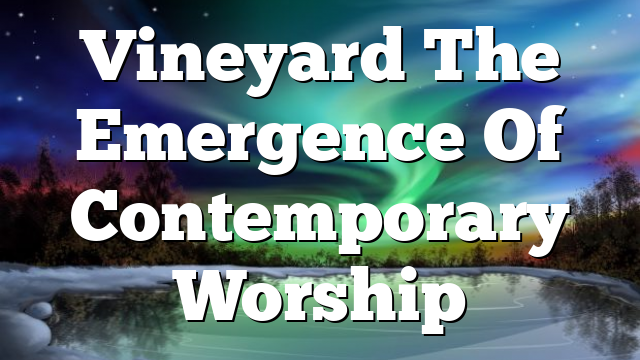Click to join the conversation with over 500,000 Pentecostal believers and scholars
Click to get our FREE MOBILE APP and stay connected
| PentecostalTheology.com



book reviews
379
Andy Park, Lester Ruth, and Cindy Rethmeier
Worshiping with the Anaheim Vineyard: the Emergence of Contemporary Worship
(Grand Rapids,mi: Eerdmans, 2017). xiii + 148 pp. $25.00 paperback.
Contemporary church worship and music may no longer seem revolutionary, yet its impact upon the larger church and ongoing significance is still a nascent area of scholarly inquiry. As part of a larger series, authors Park, Ruth and Rethmeier examine one particular congregation, the Anaheim Vineyard, and its pastor, John Wimber, as a case study to help shed light on this recent turning point in Protestant history. Largely consisting of first-person recollections and Wimber’s own words, the study allows for a close reading of a distinctive style of worship that continues to call congregations to seek renewal and intimacy with God.
The case study is organized in three parts. The first part offers a contextual setting for the Anaheim Vineyard congregation during the 1970s and 1980s, with references for further reading embedded in the narrative. The second part provides synoptic descriptions accompanying first-person recollections, photographs, song sheets, and sermons from the congregation’s early years.The third part responds to the question, “Why Study AnaheimVineyard’sWorship?” from three perspectives: as devotional study, as small group discussion, and as a more formal line of inquiry related to academic disciplines. Throughout the text, critical apparatuses—in the form of sidebar explanations and reflection prompts—are intended to set up a dialogue with the reader’s own experience, spurring reflection on what it means to worship God.
The context for the Anaheim Vineyard of the 1970s and 1980s begins with the social forces shaping the Baby Boomer generation in general, and church culture of Southern California more specifically. Describing the “Liturgical Landscape” the authors situate the emergence of the Vineyard in relation to developments of the time, including church growth strategies leading to megachurches, and the Liturgical Renewal of mainline traditions. The Charis- matic Renewal Movement receives special mention as it encouraged a sense of immediacy of God’s presence. Geographical considerations are also noted, particularly in terms of relational connections to Calvary Chapel of Costa Mesa, ca, and the growing trend of churches choosing to adapt worship styles to the culture (17). The list of methodological challenges for the study (20–21), along with significant themes (22–25), sets up the reader to engage meaningfully with the source material provided in the second part.
Unlike historical studies that are entirely reliant upon texts and documents for reconstructing worship practices, this study balances written pieces with first-hand accounts, photos and other artifacts, to offer a contoured rendering
© koninklijke brill nv, leiden, 2017 | doi: 10.1163/15700747-03903004
1
380
book reviews
of worship at the Anaheim Vineyard. Part two provides the bulk of the text, including descriptions of the congregation’s worship in terms of place, space, songs and overall experience. Remaining true to the series’ intent of “allowing readers to sense the texture” (viii) of this congregation’s worship experience, Andy Park’s descriptions at the beginning of the section immerses the reader in the early community’s practices and values. Themes noted in the previous section become visible, particularly around healing prayer and the ministry of the Holy Spirit in relation to the role of music. Cindy Rethmeier provides reflec- tions shared by individuals who were present during the early years, which, in addition to sermon excerpts from Wimber himself, explore the significance of worship as intimate encounters with God’s presence, and the expectancy that was nurtured as a result.
The aim of the third part is to facilitate a means of in-depth engagement with the preceding sections tailored to the reader. For individuals, the authors provide suggestions and questions for devotional use. Small groups are invited to reflect on the nature of worship as demonstrated through the source mate- rial. Finally, scholars and students of various disciplines are given summary prompts and discussion questions pertaining to particular areas of interest (e.g. Christian worship, preaching, and church history). The strength of this final section may be most felt by study groups seeking to better understand an array of critical questions and concerns regarding the nature of contemporary Chris- tian worship.
This study offers significant insights into the dynamic themes of early Vine- yard worship including intimacy with God, expectancy of God’s nearness, and the ministry of the Holy Spirit. The variety of documents (songs, sermons, per- sonal reflections), while not extensive, permits the reader to steep themselves in the language and logic of the Anaheim community as it developed under John Wimber’s leadership. In this way, it facilitates theological reflection on the notion of worship for today, and prompts further inquiry into the relation- ship between the presence of God in community, and demonstrations of God’s power. This resource is especially edifying for pastors and worship leaders, yet is written for a general audience, including anyone interested in studying con- temporary worship and music. The text itself seeks to limit interpretive and analytical work, and instead the reader is given resources to pursue further reading. First-person recollections are framed with concise narrative descrip- tions that locate the extended quotes, as well as help articulate some challenges of constructing history with little documentation. The authors recognize that this study is not intended to be comprehensive and that there are more direc- tions to pursue. For example, while much attention has focused on John Wim- ber as a primary figure, other leaders contributed to shaping the movement
PNEUMA 39 (2017) 365–424
2
book reviews
381
through song creation and teaching resources (70). Future studies may seek to learn more about the Vineyard of the 1970s, under Kenn Gulliksen’s leadership or examine more closely the Quaker influences on John and Carol Wimber’s approach to ministry.
Where today worship and music can be seen as synonymous to the point of becoming problematic, this case study of the Anaheim Vineyard shares the challenges of experiential worship, while sharing significant insights of a community who pursued returning to the heart of Christian worship.
Kristen Daley Mosier
Garrett-Evangelical Theological Seminary, Evanston, Illinois
kristen.daley-mosier@garrett.edu
PNEUMA 39 (2017) 365–424
3


